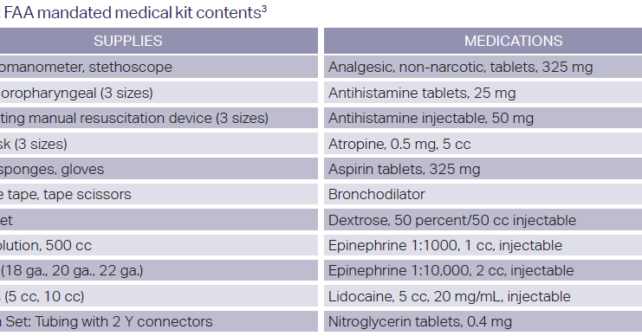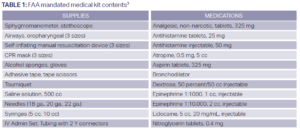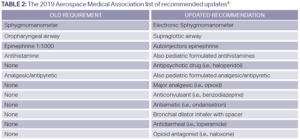
You are 40,000 feet in the air, flying across the Atlantic Ocean when the intercom crackles to life and you hear the words you’ve dreaded ever since graduating medical school: “Is there a doctor on board?”
Explore This Issue
ACEP Now: Vol 41 – No 12 – December 2022After showing the flight attendant your credentials, you meet the passenger: a 53-year-old man with difficulty breathing and a rash. The patient is audibly wheezing. The flight attendant hands you a medical bag, but you can’t hear anything with the disposable stethoscope over the turbulence. The rash on his arms and chest appears to be urticaria, and his tongue and lips are mildly swollen. Anaphylaxis, you decide, but what can you do? You peer skeptically at the emergency medical kit, which suddenly seems much smaller than you want. What medicines are even in there?
The Situation
In-flight emergencies occur in about one in 604 flights, with complaints most commonly ranging from syncope (37 percent of in-flight emergencies) to respiratory issues (12 percent), vomiting (six percent), and cardiac complaints (eight percent).1,2 When an emergency physician or nurse isn’t available, flight staff are trained in basic life support and can often avail themselves of an on-the-ground medical communications center with real-time advice.1,2,3 Whether or not on-board medical help is available, one in 14 flights with medical emergencies is diverted from their original destination to the nearest airport in the vicinity of appropriate medical facilities.1,2
The Emergency Medical Kit
The Federal Aviation Administration (FAA) requires every major commercial airplane to carry an Automated External Defibrillator (AED) and a standard medical kit (see Table 1).3 The guidelines for this medical kit have not been updated since 2006, though in 2019 the Aerospace Medical Association was tasked by the FAA with producing a list of recommended (though not required) updates (see Table 2).3,4 Many airlines have chosen to supplement the kit with additional supplies or medicines. While this does provide some much-needed fortification to the core FAA kit, it does result in variation between airlines, so a medical volunteer during an in-flight emergency may not be familiar with the available supplies. Of note, FAA exemption number 10690, which has been in effect since 2013 and was recently extended, allows airlines to not immediately update their kits with atropine, dextrose, epinephrine, and/or lidocaine under special shortage considerations.5 This means that medical kits may not always include these lifesaving and previously mandated medications. Similarly, these medications may be expired as there is no strict enforcement on checking expiration dates of medications. When assisting in an in-flight medical emergency and finding yourself short of epinephrine or other medication, it’s worth having the flight attendant ask passengers, as combined they often carry a cornucopia of personal pharmaceuticals or personal medical equipment.
Legal Considerations
On flights within the United States, as a health care professional, you are protected under Good Samaritan laws, meaning that you are not required to assist and if you choose to do so, you are protected from lawsuits (barring gross negligence or willful misconduct).6 This was codified under the Federal Aviation Medical Assistance Act of 1998 and applies to non-U.S. carriers as well.6 However, on international flights, rules and regulations are different and often differ to the country in which the airlines are based or sometimes which countries’ airspace an aircraft is at the time of an event. It’s important to note that some countries, such as Australia, require physicians to help.
Case Resolution
Since there’s no EpiPen auto-injector in the medical kit, you painstakingly draw up the epinephrine into a syringe and inject it into the patient’s thigh. The patient rapidly improves, and after observing him for a little longer, you return to your seat. As a reward, the flight attendant brings you a handful of extra snacks, including a bag of salted cashews. You cringe a little as you wonder: Who else on this flight has an allergy to nuts?
 Dr. Görgens is resident fellow of ACEP Now.
Dr. Görgens is resident fellow of ACEP Now.
 Dr. Ho is assistant editor of ACEP Now.
Dr. Ho is assistant editor of ACEP Now.
References
- Peterson DC, Martin-Gill C, Guyette FX, et al. Outcomes of medical emergencies on commercial airline flights. N Engl J Med. 2013;368(22):2075-2083.
- Martin-Gill C, Doyle TJ, Yealy DM. In-Flight medical emergencies: A review. JAMA. 2018;320(24):2580-2590. doi:10.1001/jama.2018.19842
- Ballough, JJ. Federal Aviation Administration Advisory Circular 121-33B: Emergency Medical Equipment. https://www.faa.gov/documentLibrary/media/Advisory_Circular/AC121-33B.pdf. Published January 12, 2006. Accessed November 13, 2022.
- Aerospace Medical Association Air Transport Medicine Committee. Guidance Document. https://www.asma.org/asma/media/AsMA/Travel-Publications/FAA-med-kit-Guidance-Document-June-2019.pdf. Published June, 2019. Accessed November 13, 2022.
- Federal Aviation Administration. Exemption No. 10690J, Regulatory Docket No. FAA-2013-0034, Extension of Exemption. https://www.regulations.gov/document/FAA-2013-0034-0039. Published March 29, 2022. Accessed November 13, 2022.
- Family Practice Management editors. How to respond to mid-air medical emergencies. Blog post. https://www.aafp.org/pubs/fpm/blogs/inpractice/entry/good_samaritan.html. Published July 20, 2018. Accessed November 13, 2022.
Pages: 1 2 | Multi-Page






One Response to “How To Prepare for In-Flight Emergencies”
December 18, 2022
Doron Spierer, MDIf the airline gives the Physician a gift (credit, miles, or even a bag of salted cashews) after rendering medical aid to a fellow passenger, could this be construed as compensation, thus jeopardizing Good Samaritan status?